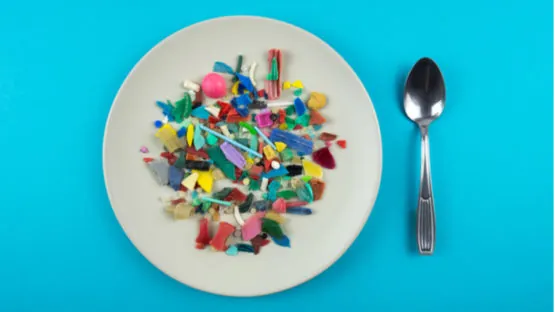Scientists have found that exposure to plastic nanoparticles drives cellular senescence and dysfunction in endothelial cells taken from a pig’s coronary artery [1].
A widespread pollutant
Plastic has changed the face of civilization, but the convenience of plastic comes at a price – mostly in terms of environmental pollution from plastic manufacturing and waste. There has also been a growing understanding that plastic pollutes us as well. Plastic can disintegrate into microparticles and nanoparticles, the latter of which are 1-100 nanometers in size and can be suspended in the atmosphere for prolonged periods of time and enter the body through breathing. Exposure can also occur via ingestion or even absorption by the skin [2] – for instance, following contact with plastic food packaging.
The research into the effects of plastic micro- and nanoparticles on human health is still in its infancy. There have been indications that thee particles in the blood drive pulmonary hypertension and vascular occlusions [3]. Still, the impact of plastic nanoparticles on human health remains mostly unclear.
Increased senescence
In this new study, the authors investigated the effect of plastic nanoparticles on cellular senescence, a major driver of aging. In particular, senescence in vascular endothelial cells, which compose the inner layer of blood vessels, is known to promote cardiovascular dysfunction [4].
The researchers used endothelial cells taken from a pig’s coronary artery, subjecting them to various concentrations of 25-nanometer particles of polystyrene, one of the most ubiquitous types of plastic. In the first experiment, the nanoparticle solution induced senescence in the cells in a concentration-dependent manner. The effect, as measured by ß-galactosidase levels, was small and statistically insignificant for the lowest concentration of 0.1 µg/mL but much larger for 1 and 10 µg/mL.
The scientists then checked for three other popular markers of senescence, the proteins p53, p21, and p16. Those were also upregulated by the treatment, with p53 being significantly elevated even by the 0.1 µg/mL solution.
Cellular senescence basically does not affect the viability of cells: they stop proliferating but continue to exist, producing harmful molecules that promote inflammation and induce senescence in neighboring cells. Subsequent experiments indeed showed that while nanoparticle exposure did not affect the cells’ viability, it significantly reduced their proliferation.
Nanoparticles cause functional decline
Higher levels of cellular senescence after the nanoparticle exposure manifested in functional decline as well. Exposing specimens of arterial tissue to nanoparticles for 24 hours significantly hampered their reactivity – a measure of how well an artery responds to stimuli by contracting and relaxing.
Senescent vascular cells are characterized by reduced production of nitric oxide (NO), a vasodilator crucial for vascular health. Sure enough, nanoparticle-exposed cells had much lower levels of the NO-producing enzyme epithelial nitric oxide synthase (eNOS).
Nanoparticles also significantly increased the levels of oxidative stress, even in the lowest concentration. Several pathways can contribute to oxidative stress, but experiments showed that nanoparticle exposure significantly affected one of them, the NADPH/Sirt1 pathway, which includes downregulation of the Sirt1 protein. Treatment with a NADPH inhibitor ameliorated the nanoparticle-induced increase in oxidative stress, as did treatment with a Sirt1 activator. The antioxidant drug NAC had a similar effect and restored proliferation levels in the exposed cells. This is not the first time that plastic nanoparticles have been implicated in increasing oxidative stress, both directly and by downregulating antioxidant enzymes.
Close to real-life concentrations
A major question is whether the concentrations that were used in this study bear any resemblance to real-life concentrations of plastic nanoparticles in our blood? Unfortunately, they do. While we still don’t have a lot of data on the subject, one recent study identified the mean concentration of plastic particles in the blood of healthy volunteers as 1.6 µg/ml – 1.6 times higher than the medium concentration used in this paper [5]. While that study measured the concentration of somewhat bigger particles (=700 nanometers), there is no reason to assume that the concentration of nanoparticles in the blood is any lower.
Conclusion
This paper is one of the first to directly study the harmful effects of plastic particles on the cardiovascular system. While it is too early to sound the alarm, this is an important research topic that warrants further investigation. Meanwhile, it seems possible that reasonable avoidance of plastics can be good not only for the planet but for your health as well.
Literature
[1] Shiwakoti, S., Ko, J. Y., Gong, D., Dhakal, B., Lee, J. H., Adhikari, R., … & Oak, M. H. (2022). Effects of polystyrene nanoplastics on endothelium senescence and its underlying mechanism. Environment International, 107248.
[2] Prata, J. C., da Costa, J. P., Lopes, I., Duarte, A. C., & Rocha-Santos, T. (2020). Environmental exposure to microplastics: An overview on possible human health effects. Science of the total environment, 702, 134455.
[3] Zagorski, J., Debelak, J., Gellar, M., Watts, J. A., & Kline, J. A. (2003). Chemokines accumulate in the lungs of rats with severe pulmonary embolism induced by polystyrene microspheres. The Journal of Immunology, 171(10), 5529-5536.
[4] Mehdizadeh, M., Aguilar, M., Thorin, E., Ferbeyre, G., & Nattel, S. (2021). The role of cellular senescence in cardiac disease: Basic biology and clinical relevance. Nature Reviews Cardiology, 1-15.
[5] Leslie, H. A., Van Velzen, M. J., Brandsma, S. H., Vethaak, D., Garcia-Vallejo, J. J., & Lamoree, M. H. (2022). Discovery and quantification of plastic particle pollution in human blood. Environment International, 107199.




